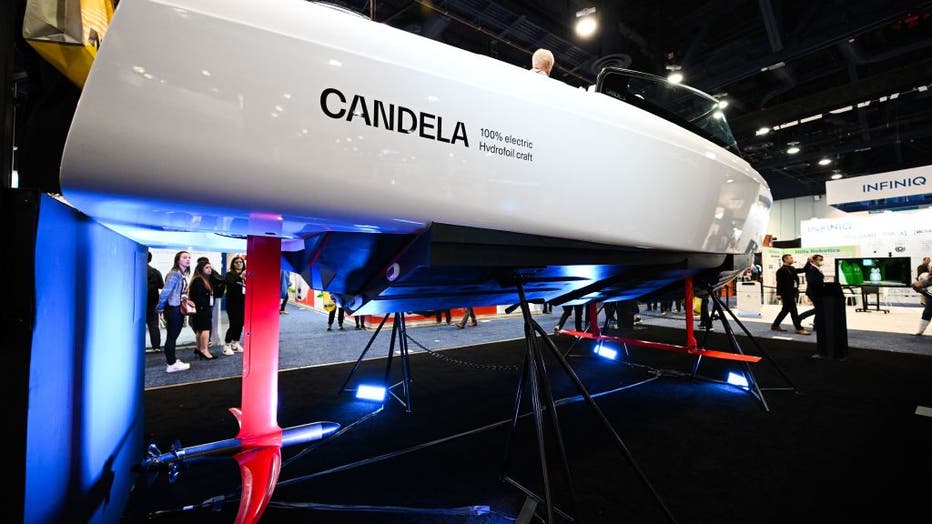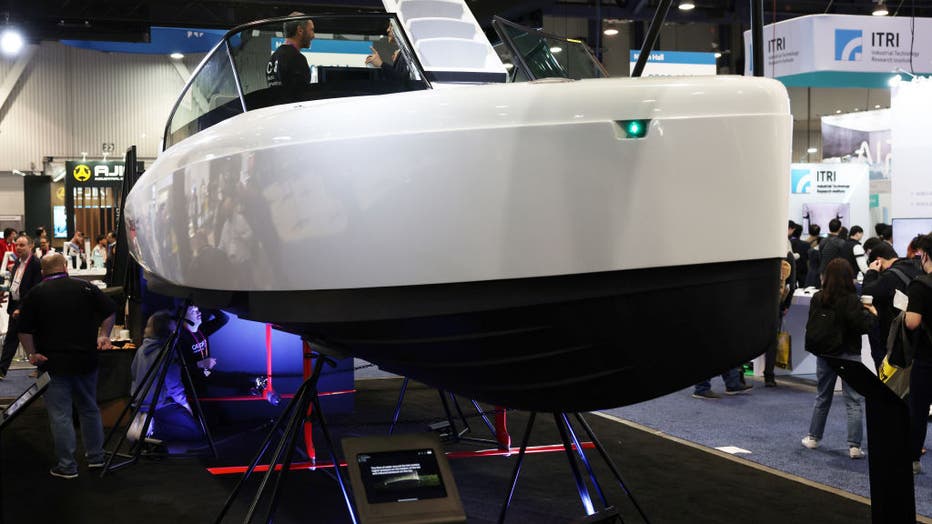Tesla of the sea? CES showcases electric hydrofoil boats

Best of C.E.S. 2023: Innovations that will shape the future
Innovative technology was showcased at this year's Consumer Electronic Show. Here are some of the best new products.
LAS VEGAS - Flying cars and self-driving vehicles always get attention at the CES gadget show in Las Vegas, but this year electric recreational boats are making bigger waves.
Swedish company Candela on Thursday unveiled a 28-foot (8.5-meter) electric-powered hydrofoil speedboat that can cruise for over two hours at 20 knots, or about 23 mph. California startup Navier tried to outdo its Scandinavian rival by bringing an electric hydrofoil that’s a little bit longer, though Candela is further along in getting its products to customers.
Even the recreational motorboat conglomerate Brunswick Corporation tried to make a splash in Nevada this week by showing off its latest electric outboard motor — an emerging segment of its mostly gas-powered fleet.
WHY ELECTRIC?
A chief reason is environmental, as well as to save on rising fuel costs. But electric-powered boats — particularly with the sleek foiling designs that lift the hull above the water’s surface at higher speeds — can also offer a smoother and quieter ride.
"You can have a wine glass and it does not spill," Navier CEO Sampriti Bhattacharyya told The Associated Press last month. "And it’s quiet, extremely quiet. You can have a conversation, unlike on a gas boat."

The Candela C-8 electric hydrofoil boat is displayed during the Consumer Electronics Show (CES) in Las Vegas, Nevada, on January 6, 2023. (Photo by Patrick T. Fallon / AFP)
WHEN CAN YOU GET ONE?
Candela CEO Gustav Hasselskog said his company has already sold and manufactured 150 of its brand-new C-8 model. The Stockholm-based startup has been scaling up its workforce from 60 employees a year ago to about 400 later this year as it prepares to ramp up production.
But with a roughly $400,000 price tag, neither the C-8 nor Navier’s N30 is aiming to replace the aluminum boat used to fish on the lake. They’ve been described as Teslas of the sea, with hopes that what starts off as a luxury vehicle could eventually help transform the marine industry.
"They tend to be entrepreneurs," Hasselskog said of Candela’s first customers. "They tend to be tech enthusiasts, if you like, with an optimistic view about the future and the ability of technology to solve all kinds of societal challenges."
Navier’s investment backers include Google co-founder Sergey Brin, which means he’s probably getting one, too.
ARE BOATERS READY FOR THIS?
Probably not. These early electric boat models are expensive, heavy and could instill more serious "range anxiety" than what drivers have felt about electric cars, said Truist Securities analyst Michael Swartz, who follows the leisure boat industry.
"How safe is it for me to go out in the middle of the week with no one around, miles from shore, in an electric outboard engine?" Swartz said.
Swartz said they might make more sense to use electric motors — such as a new CES offering from Brunswick-owned Mercury Marine — to power a fleet of small rental boats, perhaps at the widely-used boating clubs also run by Brunswick.
"You’re not anywhere near the type of electric boat where you can go 50 miles offshore and go fishing for a couple of hours and come back," Swartz said. "There’s no technology that can enable you to replicate that experience outside of an internal combustion engine."

The Candela C-8 electric long-range cruiser is on display at CES 2023 at the Las Vegas Convention Center on January 06, 2023 in Las Vegas, Nevada. (Photo by Alex Wong/Getty Images)
BRING ON THE WATER TAXIS?
Both Candela and Navier are planning for a secondary market of electric ferries that could compete with the gas-powered vehicles that now carry commuters around populated regions such as the Stockholm archipelago or along San Francisco Bay.
Hasselskog said the same technology powering Candela’s new leisure boat will also be used to power a 30-passenger catamaran prototype that could operate in Sweden by summer.
For a city like Stockholm, which has already electrified most of its public ground transportation, its dozens of large ferry boats are an outlier in producing carbon emissions.
"They need something like 220 of these (electric) vessels to replace the current fleet," Hasselskog said. And instead of running on fixed schedules with empty seats, the smaller electric vehicles might be able to be summoned on demand such as how Uber or Lyft work on land.
AUTOMATIC DOCKING
Many of the companies developing electric boat propulsion also have teams working on making these vehicles more autonomous. But since most recreational boaters like piloting their own boats — and most ferry passengers likely prefer a human captain at the helm — the self-driving innovation is focused on what happens at the marina.
"There’s an intimidation factor with boating and a lot of the intimidation factor you hear from consumers is with docking," said Swartz, the Truist analyst. "So if that can be made seamless and automated, it’s a huge deal."

